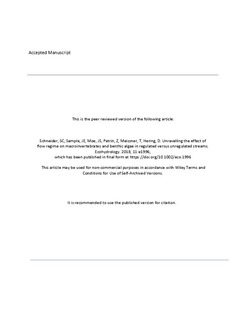| dc.description.abstract | Variability in riverine flow regimes is important for aquatic biodiversity. However, across the globe, management of water resources has altered natural flow dynamics. We explored relationships between flow regime (calculated from 3 years' daily averaged discharge), and water chemistry, benthic algae, as well as macroinvertebrate datasets from 64 sites across Germany and Norway. To deal with multicollinearity while maintaining interpretability, we performed principal component (PC) analyses for each dataset in each country and selected the metric with the highest absolute loading on each PC to represent that PC. We then used L1‐regularized (lasso) regression to link differences in water chemistry and hydrology to differences in ecology and compared this approach with the more popular best‐subsets ordinary least squares (OLS) regression. The results obtained using lasso regression were broadly comparable to those produced by best‐subsets OLS, but the lasso approach “rejected” more models than the best‐subsets approach. When lasso identified a plausible model, it was the same or similar to the best model found by best‐subsets OLS. The lasso method was more “discerning”, that is, it identified a smaller number of potentially interesting models, whereas best‐subsets regression seemed to find “too many” relationships. We identified two response variables that were potentially affected by regulation: (a) River regulation may lead to higher cyanobacterial abundance, possibly via a less variable flow regime; (b) reduced flow variability may lead to a reduced proportion of grazers and scrapers, possibly indicating a shift towards an increased importance of heterotrophic energy sources in ecosystems with less variable flows. cyanobacteria, flow variability, hydrology, indicators of hydrological alteration, macrozoobenthos, periphyton, river | nb_NO |
